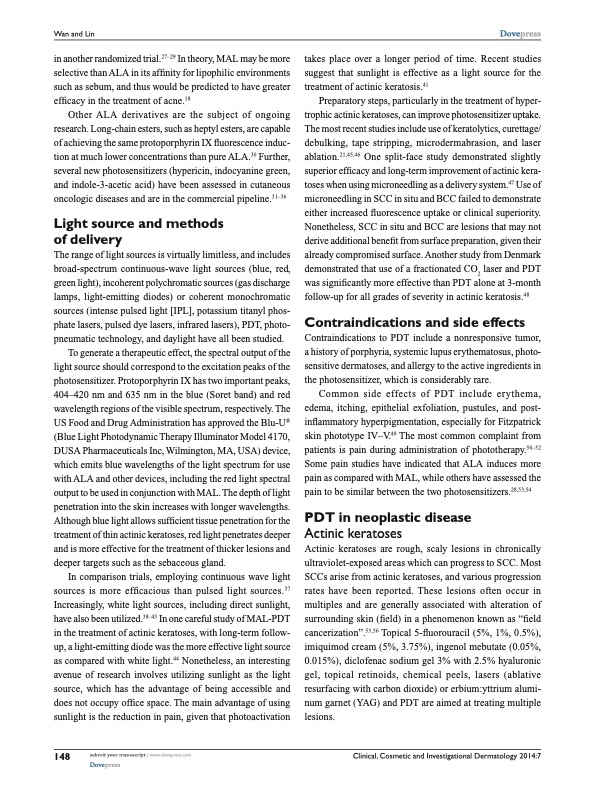
PDF Publication Title:
Text from PDF Page: 005
wan and Lin Dovepress in another randomized trial.27–29 In theory, MAL may be more selective than ALA in its affinity for lipophilic environments such as sebum, and thus would be predicted to have greater efficacy in the treatment of acne.18 Other ALA derivatives are the subject of ongoing research. Long-chain esters, such as heptyl esters, are capable of achieving the same protoporphyrin IX fluorescence induc- tion at much lower concentrations than pure ALA.30 Further, several new photosensitizers (hypericin, indocyanine green, and indole-3-acetic acid) have been assessed in cutaneous oncologic diseases and are in the commercial pipeline.31–36 Light source and methods of delivery The range of light sources is virtually limitless, and includes broad-spectrum continuous-wave light sources (blue, red, green light), incoherent polychromatic sources (gas discharge lamps, light-emitting diodes) or coherent monochromatic sources (intense pulsed light [IPL], potassium titanyl phos- phate lasers, pulsed dye lasers, infrared lasers), PDT, photo- pneumatic technology, and daylight have all been studied. To generate a therapeutic effect, the spectral output of the light source should correspond to the excitation peaks of the photosensitizer. Protoporphyrin IX has two important peaks, 404–420 nm and 635 nm in the blue (Soret band) and red wavelength regions of the visible spectrum, respectively. The US Food and Drug Administration has approved the Blu-U® (Blue Light Photodynamic Therapy Illuminator Model 4170, DUSA Pharmaceuticals Inc, Wilmington, MA, USA) device, which emits blue wavelengths of the light spectrum for use with ALA and other devices, including the red light spectral output to be used in conjunction with MAL. The depth of light penetration into the skin increases with longer wavelengths. Although blue light allows sufficient tissue penetration for the treatment of thin actinic keratoses, red light penetrates deeper and is more effective for the treatment of thicker lesions and deeper targets such as the sebaceous gland. In comparison trials, employing continuous wave light sources is more efficacious than pulsed light sources.37 Increasingly, white light sources, including direct sunlight, have also been utilized.38–43 In one careful study of MAL-PDT in the treatment of actinic keratoses, with long-term follow- up, a light-emitting diode was the more effective light source as compared with white light.44 Nonetheless, an interesting avenue of research involves utilizing sunlight as the light source, which has the advantage of being accessible and does not occupy office space. The main advantage of using sunlight is the reduction in pain, given that photoactivation takes place over a longer period of time. Recent studies suggest that sunlight is effective as a light source for the treatment of actinic keratosis.41 Preparatory steps, particularly in the treatment of hyper- trophic actinic keratoses, can improve photosensitizer uptake. The most recent studies include use of keratolytics, curettage/ debulking, tape stripping, microdermabrasion, and laser ablation.21,45,46 One split-face study demonstrated slightly superior efficacy and long-term improvement of actinic kera- toses when using microneedling as a delivery system.47 Use of microneedling in SCC in situ and BCC failed to demonstrate either increased fluorescence uptake or clinical superiority. Nonetheless, SCC in situ and BCC are lesions that may not derive additional benefit from surface preparation, given their already compromised surface. Another study from Denmark demonstrated that use of a fractionated CO2 laser and PDT was significantly more effective than PDT alone at 3-month follow-up for all grades of severity in actinic keratosis.48 Contraindications and side effects Contraindications to PDT include a nonresponsive tumor, a history of porphyria, systemic lupus erythematosus, photo- sensitive dermatoses, and allergy to the active ingredients in the photosensitizer, which is considerably rare. Common side effects of PDT include erythema, edema, itching, epithelial exfoliation, pustules, and post- inflammatory hyperpigmentation, especially for Fitzpatrick skin phototype IV–V.49 The most common complaint from patients is pain during administration of phototherapy.50–52 Some pain studies have indicated that ALA induces more pain as compared with MAL, while others have assessed the pain to be similar between the two photosensitizers.28,53,54 PDT in neoplastic disease Actinic keratoses Actinic keratoses are rough, scaly lesions in chronically ultraviolet-exposed areas which can progress to SCC. Most SCCs arise from actinic keratoses, and various progression rates have been reported. These lesions often occur in multiples and are generally associated with alteration of surrounding skin (field) in a phenomenon known as “field cancerization”.55,56 Topical 5-fluorouracil (5%, 1%, 0.5%), imiquimod cream (5%, 3.75%), ingenol mebutate (0.05%, 0.015%), diclofenac sodium gel 3% with 2.5% hyaluronic gel, topical retinoids, chemical peels, lasers (ablative resurfacing with carbon dioxide) or erbium:yttrium alumi- num garnet (YAG) and PDT are aimed at treating multiple lesions. Clinical, Cosmetic and Investigational Dermatology 2014:7 148 submit your manuscript | www.dovepress.com DovepressPDF Image | applications of photodynamic therapy dermatology

PDF Search Title:
applications of photodynamic therapy dermatologyOriginal File Name Searched:
photodynamic-therapy-dermatology.pdfDIY PDF Search: Google It | Yahoo | Bing
Cruise Ship Reviews | Luxury Resort | Jet | Yacht | and Travel Tech More Info
Cruising Review Topics and Articles More Info
Software based on Filemaker for the travel industry More Info
The Burgenstock Resort: Reviews on CruisingReview website... More Info
Resort Reviews: World Class resorts... More Info
The Riffelalp Resort: Reviews on CruisingReview website... More Info
| CONTACT TEL: 608-238-6001 Email: greg@cruisingreview.com | RSS | AMP |